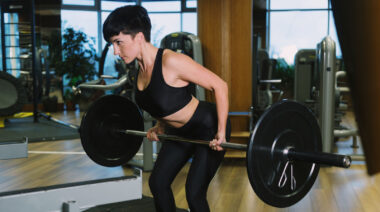If you struggle to build a thick, wide back it is probably not because your program sucks. The answer is likely much simpler than that—your technique is crap and you cannot develop a mind-muscle connection (MMC) with the muscles of the back.
Chief amongst these muscles is the latissimus dorsi (lats). The lats are the muscles that give you that awesome v-tapered look. To build your lats, the solution isn’t doing more of the same. After all, the definition of insanity is doing the same thing repeatedly and expecting a different outcome.
Tons of sets of poorly executed reps won’t make up for a lack of quality. Tweaking your rep scheme isn’t the answer if your reps are not effective. You must improve form, develop the MMC with the lats, and establish the capacity to create tension in the muscle. Only once you have done this does it make sense to increase training variables like volume, intensity, and/or frequency.
The Single Arm Breakthrough Pulldown
To achieve this, I suggest you use the single-arm breakthrough pulldown. The single-arm part of the name is fairly obvious. The breakthrough portion relates to the fact you are going to try and drive your elbow to “breakthrough” the leg pad at the bottom of the lift.
This exercise has a few key benefits compared to a traditional lat pulldown.
- Doing it one arm at a time helps you to focus all of your intention on one side. This means you can really feel the lat of the working side contracting.
- It also means your scapular muscles can move more freely and can get into a full stretch easier. When both arms a moving the range is somewhat blocked by the movement of the other shoulder blade.
- Using a rotating grip allows you to supinate your arm and reach up and away in front of the body. This creates an excellent stretch on the lats. By pre-stretching them, they can activate better when you reverse the movement. A pronated grip does not allow for this extreme stretch.
- Finally, and this is where the real magic of this exercise kicks in, using the leg pad as an immovable object to drive into guarantees you use a full range and provides some resistance to work against at peak contraction.
Often lifters hit full range, relax, and let the weight drop back into the lowering phase. As the set progresses and fatigue kicks in, they don’t even manage to reach the full range. Single-arm breakthrough pulldowns make it very obvious if you cut range.
Doing these properly with a full range on every rep has you driving into the pad for a few seconds at the bottom. This means the muscle doesn’t get any letup. Instead, you get a deep, almost cramp-like feeling in your lats which really improves your ability to feel them on other exercises. This feedback tool is an excellent way to fast track your ability to recruit your lats and make all of your back training more effective.
The way you perform your rows and pulldowns can have a massive impact on their effectiveness as lat builders. Effectively training your lats is largely down to the angle you pull at and where your elbows start and finish. Your arm path will determine if you hit the lats or your upper back and biceps more.
Lat Anatomy 101
The anatomy of the lats dictates how best to train them. The lats originate at the spine and insert onto the inside of your humerus (upper arm). The lats cover a large surface area and start out broad before arrowing in on the insertion point.
As a consequence, the fibers of the lats form a fan-like pattern. The upper fibers are more horizontal while the lower fibers have a more vertical line of pull. To best train them you need to take them through a full range and challenge them from fully stretched to their fully shortened position.
To create the v-tapered aesthetic look of golden era bodybuilders, you need to develop the lateral, lower portion of your lats. These fibers are predominantly vertical in alignment. To train them you should align the resistance in the same path. This is done by training in a vertical pull movement pattern (aka. pulldowns).
The Clue Isn’t Always In the Name
Exactly how you perform your pulldowns will determine if the lats are effectively stimulated. Almost every gym junkie uses a wide-grip, pronated lat pulldown to try and build their lats. Sadly, what they don’t realize is that this will probably build their upper back more than the lower lats that they are hoping to challenge. This is because the line of pull allows other muscles to create leverage and move the load instead of the lats.
Don’t get me wrong, pronated wide grip pulldowns are a good exercise, but they aren’t ideal to train the lats. This is especially true when the goal is the get the lower fibers fully shortened into a good quality peak contraction. The flared arm position of regular pulldown limits the workload of the lats and their ability to get into a fully shortened position.
For the lats to create leverage it is best achieved with the arms moving in an arching pattern from out in front of the body and driving in by the side—almost like a straight arm pullover pattern. Single arm breakthrough pulldowns allow you to mimic this pattern with the added bonus of having the leg pad to drive into at the end of each rep.
Hone Your Single Arm Breakthrough Pulldown Technique
Use these technique points to magnify the effectiveness of the exercise:
- Let the arm reach up and in front of the body to achieve the lengthened position—this will immediately place tension through the lats.
- Initiate the movement by pulling the elbow down and in front, NOT back. Doing so will keep tension on the lats and avoid the upper back taking over.
- Keep your arm path out in front for as long as possible. Keeping a long lever arm creates and maintains maximal tension in the lats.
- Only at the bottom of the lift do you finish by driving your elbow around into the spine.
- Imagine trying to stab your elbow through the leg pad towards the base of your spine to achieve a great peak contraction. Hold this for a 2 count.
After a few sets of 10-12 reps like this, you will feel your lats like never before.
Every rep of every set is a growth opportunity. You should aim to place tension and stimulate the target muscle on every single rep. To build your back, invest some time and effort into improving the activation of your lats with this exercise.
It will yield far superior returns than mindlessly battering away on the deadlifts, rows, and pull-ups you’ve always done. Instead, it will enhance the effectiveness of all these exercises and allow you to build that wide, powerful-looking back you want.






